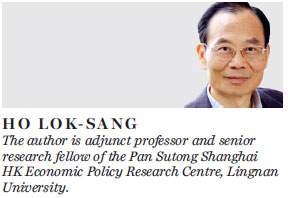Ready solutions to housing crisis
Updated: 2015-09-01 09:14
By Ho Lok-sang(HK Edition)
|
|||||||
Ho Lok-sang writes the Special Stamp Duty, which is intended to help people own a flat, is making life difficult for the most disadvantaged of aspiring home buyers
Recent reports about increasingly small flats for sale in the private market last week were very disturbing. Even more worrying was the news that buyers need only a 5 percent down payment because the developer has arranged second mortgages on top of the standard loan ratio of 60 percent approved by the Hong Kong Monetary Authority. These developments should alert us to the wrong direction of our housing policies. We really should change course. This is necessary to avoid condemning Hong Kong residents to increasingly cramped living and the possibility of buyers risking their life savings.
One private housing project in Hung Hom is offering starter homes with a usable area of 197 square feet at a cost of HK$2.97 million after all "discounts". Buyers need only pay 5 percent or HK$148,300 down and will need to pay a total of HK$10,627 for 30 years in order to pay off their mortgages. These buyers are destined for a rather miserable life in a cramped apartment. Given the present stress test requirements demanded by the Hong Kong Monetary Authority, buyers must have a family income of no less than HK$25,641 per month. This is barely above the median income in Hong Kong for all households. But it is below the median household income of HK$30,000 for economically active households. By any account, these are not well-off households. They really should not risk their life savings buying such a tiny flat. If there is a reversal in the housing market, they will easily fall into negative equity territory. Then those who can least afford it will suffer.
Indeed, it should be the SAR's policy to ensure a household can obtain a home double the size of the tiny flat at HK$3 million. A 400-square-foot flat is already a small flat. For an affluent society like Hong Kong, maintaining some minimum standard of living space should not be too much to ask.
In Singapore, the Housing and Development Board offers a full range of sizes of flats, from two bedrooms to four bedrooms. The smallest size is 36 square meters. This is about 400 square feet, and these are government-sponsored flats. The 197-square-foot flat in Hong Kong currently advertised is a private flat. Whether private or public, these flats are homes and everyone needs a minimum living space to stay mentally and physically healthy. The government may say that this is the market response to soaring housing prices. It may prefer not to intervene. But there is actually more to the price increases of tiny flats than market forces.
As noted in my recent article comparing the Special Stamp Duty (SSD) and the Double Stamp Duty (DSD), the SSD has become a big disincentive for existing homeowners to trade up to bigger and better homes. This has significantly reduced the supply of existing homes in the market while reducing demand for better homes. This is the main reason why prices of smaller homes have outstripped the prices of larger luxury homes since the launch of the SSD.
There is convincing evidence that the SSD, which was intended to help Hong Kong people to own a flat, has produced perverse results. From January 1999 through October 2010, prices of the smallest flats - 40 square meters or less - have risen by 60.3 percent. This compares with the 133.7 percent rise in the prices of the biggest flats - 160 square meters or more. In general, the bigger the flat the faster the rate of increase. This makes sense given that many Hong Kong people want to improve their housing conditions. At one time, there was a large supply of existing homes to satisfy the demands of aspiring home owners. Since October 2010, however, this pattern has reversed. The prices of Type A, B, C, D, and E flats, E being the biggest, rose by 39.3 percent, 31.6 percent, 21.5 percent, 19.1 percent, and 16.8 percent, respectively, by September 2012. The SSD was strengthened in November 2012. From November 2012 through June 2015, the prices of types A, B, C, D, and E rose by 38.1 percent, 35.8 percent, 21.3 percent, 14.3 percent, and 6.1 percent, respectively.
I see this as strong evidence that the SSD is making life difficult for the most disadvantaged of aspiring home buyers. Unfortunately, the counterproductive SSD was not only strengthened in 2012 but has the blessings of legislators. These lawmakers have little training in public policy or in housing economics.
It is time the government repealed the SSD so "trading up" can begin again. Only then can Hong Kong people hope to live in more spacious homes.

(HK Edition 09/01/2015 page10)